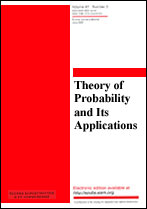|
|
Teoriya Veroyatnostei i ee Primeneniya, 1972, Volume 17, Issue 2, Pages 281–295
(Mi tvp2529)
|
 |
|
 |
This article is cited in 30 scientific papers (total in 30 papers)
Some problems concerning stability under small stochastic perturbations
A. D. Venttsel', M. I. Freidlin
Moscow
Abstract:
Let $x_0$ be a stable equilibrium point of a dynamic system $\dot x=b(x)$ in $R^r$; a Markov stochastic process $x_t^\varepsilon$ appears as a result of small stochastic perturbations of this system: $dx_t^\varepsilon=b(x_t^\varepsilon)\,dt+\varepsilon\sigma(x_t^\varepsilon)\,d\xi_t$ where $\xi_t$ is a Wiener process. Problems concerning stability of the point $x_0$ with respect to the stochastic process $x_t^\varepsilon$ are considered.
All trajectories of the process $x_t^\varepsilon$ sooner or later, leave each neighbourhood of the equilibrium point. The problem arises how to choose a region of a given area for which the mean exit time is maximum? Another problem setting: suppose that one can control the process $x_t^\varepsilon$ by chosing a drift vector $b(x)$ at each point $x$ of some set of vectors $\Pi(x)$. How should one control the process so that the mean exit time of a given region would be maximum (minimum)? Asymptotically optimal solutions to these questions are given: the control proposed by the authors is not worse (not essentially worse) than any other control if $\varepsilon$ is sufficiently small; the mean exit time of any other region $G$ of a given area is less than that of the region the authors point at if $\varepsilon$ is small.
The way of solving these problems is to estimate the main term of the mean exit time of a given region $G$ when $\varepsilon\to0$. This main term is $\exp\Bigl\{\frac1{2\varepsilon^2}\min\limits_{y\in\partial G}V(x_0,y)\Bigr\}$ where $V(x_0,x)$ is a function that does not depend on the region and can be found as a solution of a specific problem for the differential equation
$$
\sum a^{ij}(x)\frac{\partial V}{\partial x^i}\frac{\partial V}{\partial x^j}+4\sum b^i(x)\frac{\partial V}{\partial x^i}=0,\quad(a^{ij}(x))=\sigma(x)\sigma^*(x).
$$
In order to solve the optimal control problem, a non-linear partial differential equation is considered. In the case of shift-invariance this equation can be solved by means of a certain geometrical construction.
Received: 23.07.1970
Citation:
A. D. Venttsel', M. I. Freidlin, “Some problems concerning stability under small stochastic perturbations”, Teor. Veroyatnost. i Primenen., 17:2 (1972), 281–295; Theory Probab. Appl., 17:2 (1973), 269–283
Linking options:
https://www.mathnet.ru/eng/tvp2529 https://www.mathnet.ru/eng/tvp/v17/i2/p281
|


|




 Contact us:
Contact us: Terms of Use
Terms of Use
 Registration to the website
Registration to the website Logotypes
Logotypes








 Citation in format
Citation in format 
